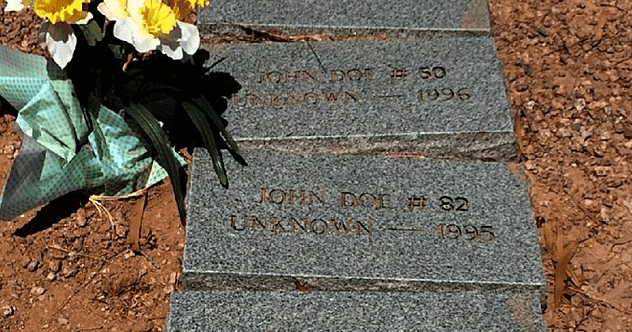When a person passes away and cannot be identified, they are often given the placeholder names Jane Doe or John Doe. Sadly, figuring out who these individuals are can be a very tough job, sometimes taking many, many years. Thanks to big steps forward in forensic science, it’s now possible to identify people who were known only as Jane or John Doe for decades. This list looks at 10 such cases where identification took over 45 years, finally bringing names to the unknown and a measure of closure to lingering mysteries.
10 Woodlawn Jane Doe
On September 12, 1976, the body of a young girl was found near Lorraine Park Cemetery in Woodlawn, Maryland. She had been strangled and sexually assaulted. Tests showed chlorpromazine, a drug used for some mental illnesses that can cause sleepiness, was in her system. Authorities couldn’t identify her then, and she became Woodlawn Jane Doe. She remained unidentified for 45 long years.
In June 2006, tests on her clothing found bodily fluids, but it wasn’t enough for a DNA match at the time. The National Center for Missing and Exploited Children released a drawing of what she might have looked like in 2016. Then, in 2021, with help from Bode Technology, new DNA testing was done. Finally, Woodlawn Jane Doe was identified as 16-year-old Margaret Fetterolf.
Margaret’s family had reported her missing in 1975 from Alexandria, Virginia. Her murder case is still unsolved and remains an open investigation.
9 Jane Doe No. 59
In Los Angeles, on November 16, 1969, a young woman’s body was found in bushes off Mulholland Drive. She had been stabbed multiple times. Police couldn’t identify her, so she became known as Jane Doe No. 59. It took 46 years to learn her name.
Her case was added to NamUs, the National Missing and Unidentified Persons System, in 2003. In June 2015, a family friend was looking at the NamUs website. She saw a photo of Jane Doe No. 59 taken after her death and thought she looked familiar. She told the family. Jane Doe No. 59 was then identified as 19-year-old Reet Silvia Jurvetson.
Reet had moved to Los Angeles from Montreal in 1969. She sent her family a postcard saying she was happy and not to worry. When they didn’t hear from her again, they thought she was just starting a new life. They never thought something bad had happened and didn’t report her missing. Reet’s murder is still unsolved.
8 Chatham County John Doe
The body of a young man was discovered in March 1976 in the Cape Fear River near Moncure, North Carolina. His head and hands were missing. Authorities thought his remains might have floated down from the Haw River or Deep River. Since they couldn’t identify him, he was called Chatham County John Doe for 46 years.
His case was put into the NamUs database in 2008. In 2020, Detective Ricky Culberson from the sheriff’s office teamed up with the NC Unidentified Project. In 2021, they worked with Othram Labs to create a DNA profile for Chatham County John Doe.
Using this DNA profile, the sheriff’s office confirmed his identity as Jimmy Mack Brooks. He was an unmarried Army veteran, 26 years old when he was murdered. Brooks’s murder case is still unsolved.
7 Mountain Jane Doe
In June 1969, a young woman’s body was found in the woods off a trail on Pine Mountain in Harlan, Kentucky. She was naked and had been stabbed multiple times. Unable to identify her, she became known as Mountain Jane Doe for 47 years.
Her description was added to the NamUs database in 2009. That same year, a woman saw the description and thought it matched her missing mother. She contacted NamUs, who connected her with the Kentucky State Police.
In 2014, NamUs and the Harlan County coroner tried to dig up Mountain Jane Doe’s grave for DNA testing. However, the grave was marked incorrectly, and they exhumed a man’s grave instead. A year later, they found and exhumed the correct grave. Her remains were sent to the University of North Texas.
In September 2016, Mountain Jane Doe was identified as 21-year-old Sonja Blair Adams. Her murder remains an unsolved case.
6 Singer Island Jane Doe
In June 1974, the skeletal remains of a young girl were found tied to a tree with wire in Palm Beach County, in an area once called “Burnt Bridges.” Authorities couldn’t figure out how she died or who she was. She became Singer Island Jane Doe for 48 years.
Her remains were exhumed in April 2014 for DNA testing. The DNA profile was entered into CODIS (Combined DNA Index System) in 2015. In 2019, the Palm Beach County Sheriff’s Office created a facial reconstruction sketch of her.
In December 2021, her remains were sent to Othram Labs. By March 2022, Othram Labs identified Singer Island Jane Doe as 15-year-old Suzanne Gale Poole. Suzanne’s family had reported her missing in December 1972.
Investigators believe Poole might have been a victim of serial killer Gerard Schaefer. He was convicted in 1973 for murdering two girls and implicated in many other deaths. Schaefer himself was killed by another inmate in 1995.
5 Coos County John Doe
The body of a teenage boy was found in Coos Bay, Oregon, in July 1971. Authorities couldn’t determine his cause of death or who he was. He was called Coos County John Doe for 50 years.
In 2017, investigators exhumed his remains for DNA testing. The sample was sent to Parabon Nanolabs and uploaded to NamUs. Parabon Nanolabs developed a DNA profile in May 2021. Two months later, this profile matched with a family member in Idaho. Coos County authorities contacted the family.
Family members gave DNA samples, which confirmed Coos County John Doe was 15-year-old Winston Arthur Maxey III. Winston had run away from his home in Boise the year he died, hoping for a better life. He planned to hitchhike along the Oregon Coast to find work. Unknown to him, he had fathered a child before he left home.
4 Jane Doe (Huntington Beach)
On March 14, 1968, a young woman’s body was found in a farm field in Huntington Beach. She had been beaten, sexually assaulted, and her throat was slit. Authorities couldn’t identify her at the time. She remained an unnamed Jane Doe for 52 years.
In 2001, investigators tested evidence from her sexual assault kit to create a DNA profile of the attacker. Blood from the victim’s clothing gave a partial DNA profile of the victim. Her DNA was put into CODIS, and her fingerprints into databases, but there were no matches. In 2010, a cigarette butt found at the scene was analyzed and matched the DNA profile from the assault kit.
In 2019, authorities used genetic genealogy to find a possible family tree for the suspect. They identified him as Johnny Chrisco, who died of cancer in 2015. In 2020, genetic genealogy was again used, this time to identify Jane Doe as 26-year-old Anita Louise Piteau. It’s not clear how Chrisco and Piteau knew each other.
3 Unknown Boy (Cahaba River)
On March 27, 1961, a driver named James White picked up a teenage boy hitchhiking on Highway 25. The boy told White his parents were divorcing and he had run away. Before White could learn more, his car hit a guard rail and plunged into the Cahaba River. White survived, but the boy drowned. Authorities couldn’t identify him, and he became known as the Unknown Boy for 60 years.
The National Center for Missing & Exploited Children paid for the exhumation of the boy’s remains in 2016. His remains were sent to the University of North Texas for DNA testing. In October 2020, Dr. Colleen Fitzpatrick, founder of Identifinders International, joined the case.
In October 2021, the Unknown Boy was identified as 15-year-old Daniel Paul “Danny” Armantrout. Authorities found Danny’s cousin in Germany and his 77-year-old brother in Florida.
2 Little Miss Nobody
On July 31, 1960, the partly buried remains of a little girl were found in the Arizona desert. Authorities thought she was about seven years old. Unable to identify her, she was named Little Miss Nobody. It took 62 years to find out her real name.
Her remains were exhumed in 2015 for DNA testing. In 2017, the Yavapai County Sheriff’s Office sent her remains to a lab in Texas for a facial reconstruction sketch, which was released in 2018. When the sketch didn’t lead to answers, the sheriff’s office raised money to send DNA to Othram Labs in 2021. In 2022, using DNA from a family member, the lab identified Little Miss Nobody as four-year-old Sharon Lee Gallegos.
Sharon had been kidnapped on July 21, 1960, while playing in an alley near her home in Alamogordo. A dark green car with a man, woman, and two children inside offered her candy and clothes. When she refused to get in, they dragged her into the car and drove off.
The FBI and Alamogordo Police, who were looking for Sharon, learned about the remains found in Arizona. They suspected a connection, but forensic science wasn’t very advanced then, and they ruled out Sharon as Little Miss Nobody. Sharon’s kidnapping and murder are still unsolved.
1 Babes in the Wood
On January 15, 1953, a groundskeeper in Vancouver’s Stanley Park found the skeletal remains of two young children. Authorities believed they had been there for about five years. They had been bludgeoned to death and were covered by what looked like a woman’s raincoat. Unable to identify them, they became known as the Babes in the Wood for 70 years.
In 1996, their remains were tested for DNA for the first time. It didn’t identify them but confirmed they were half-siblings with the same mother. The DNA also showed both children were boys; initially, one was thought to be a girl.
New DNA samples were taken in 2021, and investigators contacted Redgrave Research Forensic Services. Genealogists at Redgrave started building a family tree in January 2022. They connected the boys’ DNA with that of their great-niece, who had taken a DNA test and uploaded her profile to 23andMe.
After 70 years, the boys were identified as seven-year-old Derek and six-year-old David D’Alton, also known by the last name Bousquet. They were never reported missing. Police believe a close relative, who died about 25 years ago, murdered them. The suspect’s name has not been released.
These ten stories show the pain of unsolved cases and the power of science to bring answers, even after many decades. While identifying these individuals doesn’t erase the tragedy, it restores their names and offers a degree of closure to families and communities. The efforts of investigators and scientists continue to shine a light on the darkest of mysteries.
What are your thoughts on these incredible identification stories? Do you know of other similar cases? Leave your comment below!










